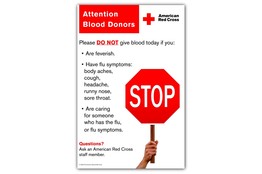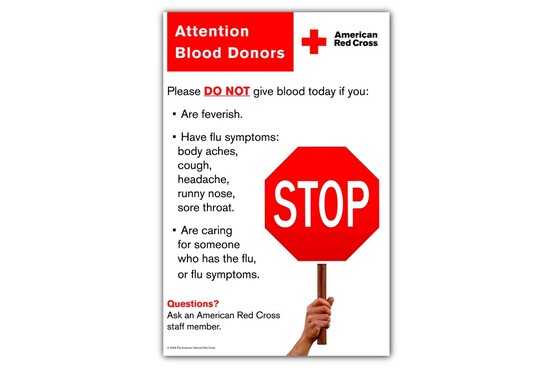The swine-flu pandemic is creating unexpected problems for the nation's blood supply—shrinking the number of blood donors and raising questions about whether the flu can be spread through a transfusion.
A number of blood centers are reporting an unusual drop in collections because too many potential donors are sick with the H1N1 virus, or swine flu. Some blood drives in high schools and corporate offices have had to be scaled back or canceled because of high levels of absenteeism.
Another problem: Some centers say a growing number of donors are calling a day or two after giving blood to say they've come down with flu-like symptoms, forcing the centers to dispose of the blood as part of government regulations. Researchers in a government-funded study are testing samples of these donors' blood for viremia, the medical term for virus in the blood.
Unlike infectious diseases such as HIV/AIDS, hepatitis C and West Nile virus, colds and flu aren't believed to be transmitted by blood. But some studies indicate that more virulent strains can be present in the blood before flu symptoms show up. "When you get into strains that are pandemic, the rules don't necessarily apply," says Matthew Kuehnert, director of the Office of Blood, Organ and other Tissue Safety at the Centers for Disease Control and Prevention.
So far, medical officials say there is enough blood to comfortably supply the 15 million units used annually in trauma units, operating rooms and elsewhere. But blood centers have begun working with the federal government and hospitals to put emergency planning measures in place, such as allocating blood only to the sickest patients, should the pandemic worsen or return in a more virulent form next spring.
"We are very worried about the impact of swine flu," says Marsha Springel, donor resources manager at the Miller-Keystone Blood Center in Bethlehem, Pa., which serves eight counties in Pennsylvania and New Jersey. "Right now we have an ample supply, but if this hits as big as they are predicting, we will lose the schools, and they are a large proportion of our donor base," she says.
At one high-school drive last week, high absenteeism meant Miller-Keystone collected just 33 units of blood, instead of the 70 to 80 units they had expected. And over Halloween weekend, a local ski club had to cancel a drive because so many members were ill.
As of last week, 48 states reported widespread influenza activity, with almost all the illnesses identified so far as swine flu, according to the CDC. While visits to doctors for flu-like illnesses decreased slightly last week after four consecutive weeks of sharp increases, they are at much higher levels than what is expected at this time of year. Parts of the country are still seeing sharp increases in activity and it is possible that illness rates could rise again.
At donor centers, blood is separated into red blood cells, platelets and plasma, then undergoes 14 tests, including 11 for infectious agents such as HIV to ensure its safety. Blood is then labeled by type, stored at appropriate temperatures, and distributed to hospitals as needed. Centers are concerned that the supply they keep on hand—typically three to five days' worth of blood—could quickly become stretched if more donors fall ill.
Declining Turnout
America's Blood Centers, an association of independent facilities that combined collect about half the U.S. blood supply, says that 27% of its member centers are reporting a decrease in overall collections due to swine flu. Nearly a quarter of the centers reported that collections have dropped at high schools, which have been one of the fastest-growing sources of blood donations in recent years as more states allow students as young as 16 to donate. And more than 15% of centers reported declines in blood collections from colleges and from corporations, where layoffs and plant closings have hurt blood drives. Association members reported that the declines are manageable.
At Lane Memorial Blood Bank in Eugene, Ore., which supplies three hospitals in the area, Executive Director Doug Engel says absenteeism rates of up to 35% at local high schools have put a dent in collections. The blood bank is now calling schools and companies that sponsor drives a few days ahead to check on absentee rates, and may send a mobile van instead of setting up drives in high-school gymnasiums to save costs.
Partly offsetting the reduced collections is lower blood demand as more people put off costly elective surgeries due to the tough economy, says Richard Benjamin, medical director of the Red Cross, which supplies about 43% of the nation's blood. But a looming worry is the upcoming holiday season, when it is traditionally harder to recruit donors. "If swine flu continues on its path, disrupting blood collections during that period, we are really going to need more donors," Dr. Benjamin says. The Red Cross and its local chapters are turning to social-networking sites such as Facebook and Twitter to get the word out about the need for blood.
Medical experts generally don't believe colds and flu can be transmitted by blood, and no case of seasonal influenza transmitted by blood has ever been reported in the U.S. But there also has been little active surveillance for flu in the blood supply.
The National Institutes of Health since the late 1980s has funded studies of blood safety through a program known as the Retrovirus Epidemiology Donor Study, or Reds, to determine the prevalence of HIV among blood donors and the risks of transmitting HIV and other viruses via transfusions. As part of a second phase of that study, researchers in 2006 began examining whether influenza virus could be detected in blood. Philip Norris, associate director of the Blood Systems Research Institute in San Francisco, and a lead investigator on the project, says testing of hundreds of blood donors at risk for seasonal influenza hasn't revealed any evidence of influenza virus in the blood. He says his group is repeating the study with new blood samples "in case our assumption that H1N1 will behave like seasonal influenza is wrong."
Dumping Blood
Food and Drug Administration regulations require blood centers to turn away would-be donors who have any symptoms of illness. And any donor who falls ill shortly after giving blood is asked to notify the center where they donated so their blood can be removed from inventory. So far, the swine flu has turned out to be less infectious than medical experts at first feared. Still, because many patients who get blood transfusions have weak immune systems, a flu infection transmitted through the blood could be extremely dangerous, increasing their risk of death.
The FDA says the benefits of a transfusion where medically necessary far outweigh the risks, including any "theoretical" risk of swine-flu transmission through blood or blood products. But an FDA spokeswoman says the agency will continue to review any new scientific information about the potential risks and may revise its recommendations "as appropriate."
When a new threat is discovered, the FDA has shown it can act quickly. In 2003, a test for West Nile virus was developed and approved by the FDA that identified nearly 1,000 blood donors with the infection before their donations entered the blood supply.
Researchers are studying other risks of infection and harm from blood transfusion, such as unexpected adverse reactions to donated blood. Patients concerned about such risk can ask about donating their own blood before surgery, or having surgeons recycle any blood that may be lost during their procedures.
"Assuming the swine flu virus doesn't begin to look more virulent, we hope we can look back at H1N1 in 2009 as an important planning exercise for the future to see where our vulnerabilities lie," says Louis Katz, executive vice president, medical affairs, of the Mississippi Valley Regional Blood Center in Davenport, Iowa, and chair of a national task force on pandemic flu and the blood supply.
Meanwhile, along with screening out obviously ill patients, blood centers are taking extra hand hygiene and infection-prevention precautions to "create as safe an environment for blood donors as possible," Dr. Katz says. "The most important message is that people still need to get out there and donate blood."
Write to Laura Landro at laura.landro@wsj.com
 - Propel Your Career
- Propel Your Career









![[ INFORMED ]](SB10001424052748703808904574525570410593800_files/PJ-AS375_INFORM_NS_20091109193250.gif)
![[Germany Celebrates Fall of Berlin Wall]](SB10001424052748703808904574525570410593800_files/OB-EV651_bwall1_C_20091108182614.jpg)
![[PJ-AS368_SEASON_C_20091109182554.jpg]](SB10001424052748703808904574525570410593800_files/PJ-AS368_SEASON_C_20091109182554.jpg)
![[Anglican]](SB10001424052748703808904574525570410593800_files/NA-BB853_ANGLIC_C_20091109190010.jpg)
![[PJ-AS354_SPORT1_C_20091109182522.jpg]](SB10001424052748703808904574525570410593800_files/PJ-AS354_SPORT1_C_20091109182522.jpg)
![[MK-AZ398_B1SKY3_C_20091109182610.jpg]](SB10001424052748703808904574525570410593800_files/MK-AZ398_B1SKY3_C_20091109182610.jpg)
![[Heyman]](SB10001424052748703808904574525570410593800_files/NA-BB852_HEYMAN_C_20091109185426.jpg)
![[PH-AA100_PHCOVE_C_20091104125902.jpg]](SB10001424052748703808904574525570410593800_files/PH-AA100_PHCOVE_C_20091104125902.jpg)
![[MK-AZ362_SP_FEA_C_20091108180254.jpg]](SB10001424052748703808904574525570410593800_files/MK-AZ362_SP_FEA_C_20091108180254.jpg)
![[MK-AZ352_BOSSTA_C_20091108163925.jpg]](SB10001424052748703808904574525570410593800_files/MK-AZ352_BOSSTA_C_20091108163925.jpg)
![[MK-AZ386_CHAIR_C_20091108173830.jpg]](SB10001424052748703808904574525570410593800_files/MK-AZ386_CHAIR_C_20091108173830.jpg)
![[Jimmy Clausen and Notre Dame]](SB10001424052748703808904574525570410593800_files/OB-EV621_cfoot__C_20091108122601.jpg)
![[Investor]](SB10001424052748703808904574525570410593800_files/MI-AZ616_WINVES_C_20091106174146.jpg)
![[PT-AM914_Cover__C_20091106223857.jpg]](SB10001424052748703808904574525570410593800_files/PT-AM914_Cover__C_20091106223857.jpg)




Hello
Your question to the Journal Community Your comments on articles will show your real name and not a username.Why?
Why use your real name? The Journal Community encourages thoughtful dialogue and meaningful connections between real people. We require the use of your full name to authenticate your identity. The quality of conversations can deteriorate when real identities are not provided.
Create a Journal Community profile to avoid this message in the future. (As a member you agree to use your real name when participating in the Journal Community)